"If you don't like what you're doing, you can always pick up your needle and move to another groove." -Timothy Leary
Up in the night sky, shortly after sunset, the night sky holds some spectacular sights. Some are permanent, some are transient, some have been known for thousands of years, and some are still being discovered. Looking to the west after sunset tonight, this is what you're likely to see.
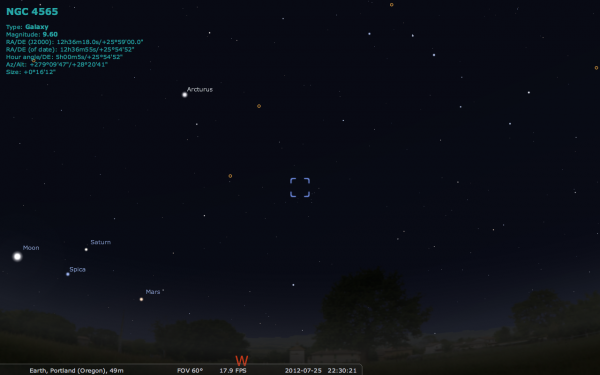
Image credit: Me, using Stellarium, available free at http://stellarium.org.
The Big Dipper, perhaps the most famous collection of seven stars in the night sky, looms large over the horizon. As always, you can follow the "arc" of the handle to Arcturus, the orange giant that's the brightest star in the northern hemisphere, and "speed on" towards Spica, a blue giant that's still the 15th brightest star in the sky despite being 260 light years away.
Next to Spica, you can find Saturn, Mars, and the Moon. The Moon is just there for tonight; it will move on by by tomorrow. Saturn will be there all year, while Mars will actually pass through the line created by Spica and Saturn on August 13th. (And don't forget to think about Mars on August 5th/6th.) But it isn't these transient, nearby worlds that I'm here to tell you about today, nor even the stars that are many light years distant. Instead, I want us to turn millions of light years away, to the distant galaxies that lie far beyond any star in the Milky Way.
Dim, faint, and with very diverse appearances, most galaxies are either elliptical (center), or spirals (left and right). But the spiral structure isn't always visible, as you can see, because occasionally the spiral galaxy appears on its edge from our point of view.
Today, I'd like to introduce you to perhaps the most spectacular, completely edge-on spiral galaxy in our night sky: the Needle Galaxy. To find it, find the Big Dipper and Arcturus in the night sky, and point your telescope at the area where the blue rectangle is two images above. Your finderscope will likely show you a cluster of stars like this.
This collection of stars -- not at all prominent to the naked eye but spectacular through binoculars -- is known as Coma Berenices, and is both a traditional and modern constellation in the night sky. There are seven bright galaxies within Coma Berenices that were included in the first catalogue of deep-sky objects by Charles Messier. But one prominent bright galaxy, the edge-on Needle Galaxy, was somehow missed.
And through a telescope, it is spectacular.
At maybe 50 million light years distant, it's one of the closer galaxies to us in the night sky, and arguably (by me, certainly) the most spectacular galaxy that Messier inexplicably* missed in his catalogue. At even this relatively tame distance, the Needle Galaxy is caught up in the expansion of the Universe, and speeds away from us at over 1,200 kilometers per second, or about 0.4% the speed of light!
Because it's edge-on to us, we're able to use it as a perfect example to show how much larger the central, bulging region of a spiral galaxy is compared to the "thin-disc" portion.
The image above, by the European Southern Observatory, also shows off just how close this galaxy is to us, because the small, faint, fuzzy objects in the background here are also galaxies, only much more distant than the Needle Galaxy.
The best single-image of the Needle Galaxy, which shows off its bulge, its slightly warped disc, its various colors, and its light-blocking dust lanes that I could find for you was taken with "only" a 24-inch telescope in Arizona.
But the highest-resolution image of this galaxy? As always, we've got to turn to the Hubble Space Telescope for that. The field-of-view for Hubble is so small compared to this galaxy that with the Advanced Camera for Surveys, we're unable to fit the entire galaxy into the picture.
For as far as color, sharpness and resolving the individual features within the galaxy, Hubble still can't be beat. For a galaxy that's this far away, we can -- and this is truly amazing -- identify regions where new stars have just formed: open star clusters!
By using the original resolution image, I can even pick some of them out for you.
These bright blue regions only exist where the brightest, hottest and youngest stars are located, and you can see two very prominent ones clearly, above, just beneath the light-blocking dust lane, which no doubt shrouds many more star-forming regions.
But, as with all Hubble images, my favorite thing to do is to hunt for background galaxies.
Just as spectacular as any galaxy in the night sky, coming in a variety of colors, sizes, and morphologies (that's your astronomy word of the day; it means "shapes"), these background galaxies only appear as they do because of the great distances between them and Earth. A region of space as big as the one images by the main Hubble image -- one not even containing the entire Needle Galaxy -- will contain around 10,000 background galaxies, of which maybe 1,000 are visible to a diligent galaxy hunter.
Because it isn't just the big, extended shapes above that are galaxies; it's every distant point of light that isn't a star within our own galaxy. The one true "Space Needle" points the way not just to a distant, island Universe, but helps give us a window into the massive expanse of space that lies beyond. And that's from looking at just one galaxy that wasn't even prominent enough to make it into the Messier catalogue. Well, Charles (and his assistant, Pierre Méchain), bet you wish you'd included it now!
* -- There are plenty of deep sky objects that Messier missed because he couldn't observe them from his location on Earth. While it's hard to fault him for that, he's got no excuse for the Needle Galaxy!

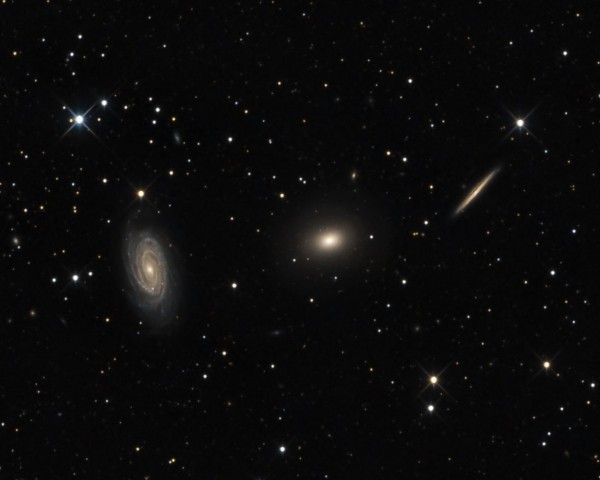
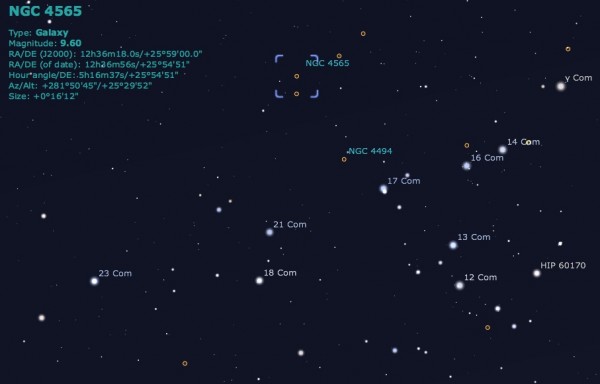
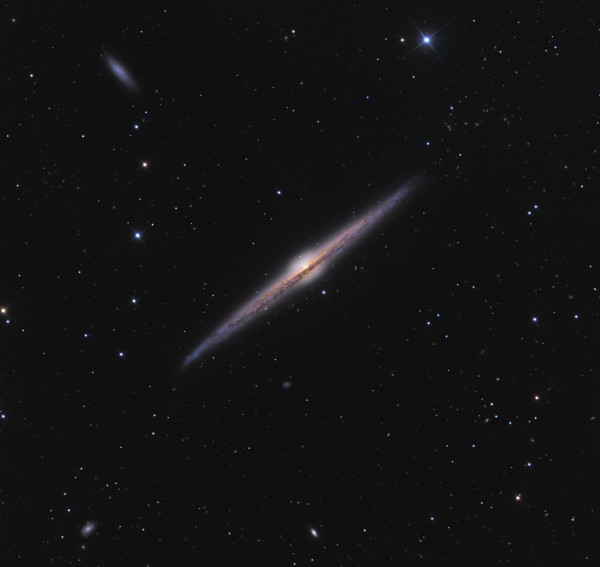
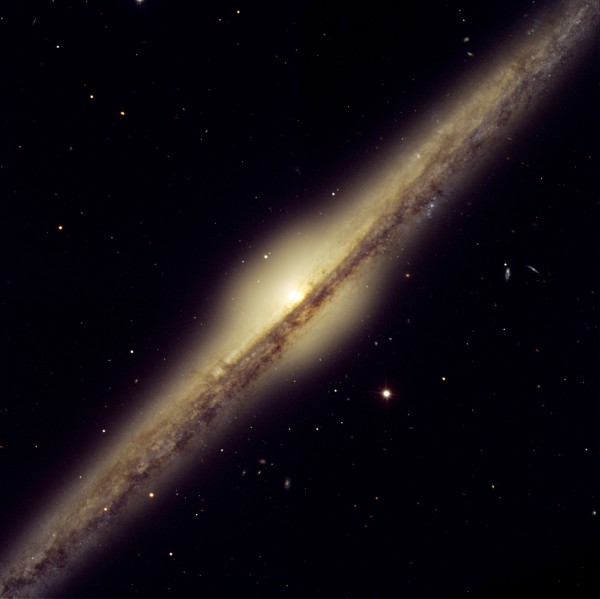

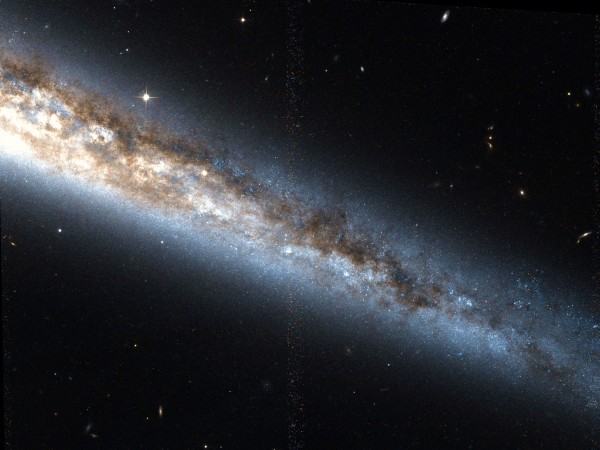
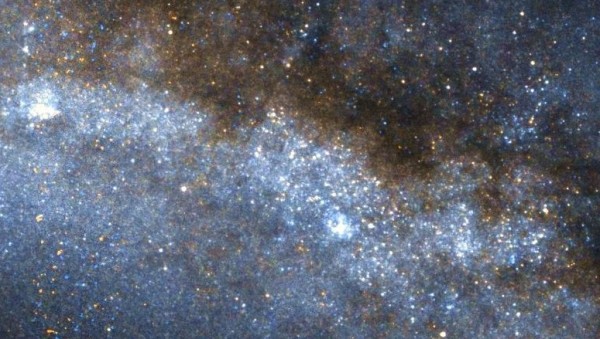
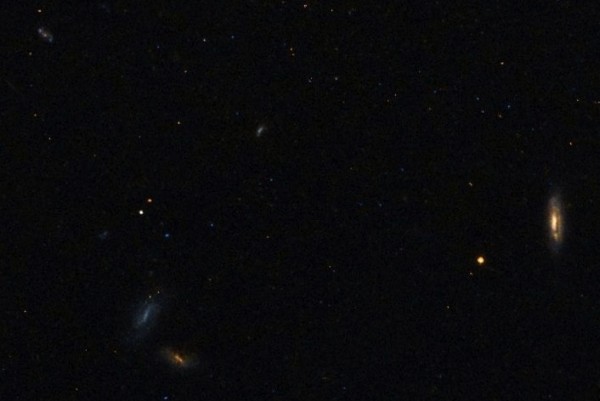
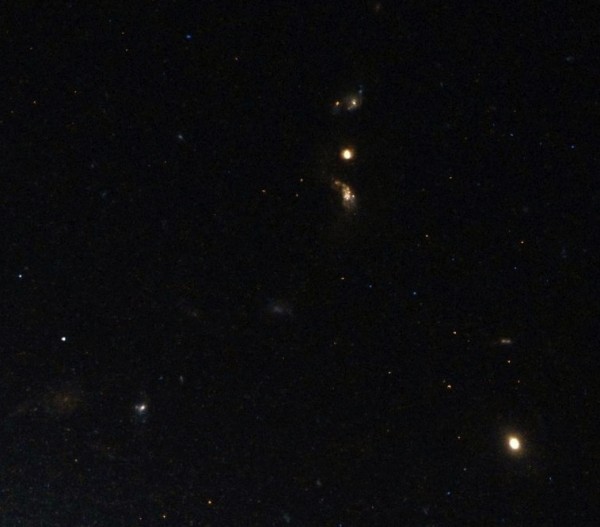
Great article. I liked the lead in which had me exptecting to stay in our galaxy when suddenly you wisked us off to deep space. Look mom, I'm flying!
(4th picture from the bottom) Whats with the bands of blue and red dots that border the edges and run down the center of this image? They are too geometric to be naturally occuring and I suspect its a result of patching smaller images together, but can anyone explaing whats actually happening?
@Ethan: "Labels not included with your night sky".
Why not? Maybe I'll wait for the "Night Sky version 2"....
LOL
> (4th picture from the bottom) Whats with the bands of blue
> and red dots that border the edges
> and run down the center of this image?
As you guessed, they are due to the bad pixels at the very edges of the CCD chips in the camera used to take this picture. The picture is a combination of several smaller images, each of which had regions of higher noise around the edges. The region of overlap contained some of these noisy pixels, and so the finished mosaic has extra noise there, too.
Thanks Ethan.
You keep encouraging me to learn more about astronomy. And I like that.
Noticing Stellarium at the bottom of one photo; I decided to search out what apps are available for outdoor astronomy use with my ipad. I've decided to download Stellarium to my desktop (but not available for iPad). So I've selected and decided to test try three free ipad apps. Star Safari 3, Go sky Watch Planatarium, and NASA App HD.
I plan to go out with my son, ipad, binoculars and telescope and look at the moon, Jupiter, Mars and Spica tonight. So thanks for encouraging to keep learning. I hate to admit how ignorant I am about astronomy.
Reading online; it seems that many recommend the iPad as a great field astronomy tool. So with my computer loaded and my iPad loaded, just maybe I'll learn a bit more about astronomy and star watching.
Thanks for keep pointing me to the sky and educating me about our universe.
"he’s got no excuse for the Needle Galaxy!"
IMHO he has. He was a comet hunter. To avoid false alarms he made a checklist of comet-like fuzzy targets that are not comets. The Needle Galaxy doesn't look like a comet, therefore it need not be on the list.
I've put Stellarium on my desktop; it's a really app, reference and easy to use. And free.
Star Safari 3 is on my iPad now and it's amazing!!!!
I'll take it outside with me tonight. Works without wifi connection (I suppose I get something extra when connected, don't know what yet)
NASA app HD is a great reference but needs to be connected to wifi
I'll delete Go Sky Watch Planatarium it just doesn't compare with Star Safari 3.
Thanks Ethan for educating and motivating me.
i've learned alot in the last year reading your posts... congrats. on being w. nat. geo now... thanks 4 the clear and concise science /astro. updates... !
Why did messier have M40 which was a double star, but not caldwell 14?
In his catalogue there are two stars that NEVER coukd appear as a comet like object.
Man was a loon!
@OkThen
Another App you may wanna try is Star Walk. It's $3.99 but well worth the investment.
@ Michael, thank you for the explanation.
@ Dr. S, you mentioned open star clusters, which reminds me of a question I have had for a long time. I hate to cut and paste here, but Pamela Gay can illustrate this a lot more effectivly then I ever could. She's talking about the earliest super massive black holes. Basically the puzzle is how did the gas clouds turn into super massive black holes instead of just forming open star clusters. I'm wondering if we have any new theories of how this can be explained. Anyway, here's what she said.
"This is something we’re still struggling with, and the problem is that, how do you get that much mass to collapse all at once without fragmenting into stars? If you think about all the episodes that we’ve done on star formation: you start out with a giant cloud of material, something nudges the giant cloud of material, and it starts to collapse, it starts to rotate, it starts to fragment, it starts to form stars… Well, what caused (in the early universe) some of those collapsing bits to, instead of fragmenting into stars, to just go “Whump! I’m a super-massive black hole?” And we know the super-massive black holes formed fast, formed early, because as we look at galaxies further and further back in time, we notice that this relationship between the size of the black holes and the size of the galactic bulges starts to break down. It starts to be that the black holes are bigger than they should be, which tells us it’s the black holes that probably came first and drew everything in around them. So we have to figure out how to compensate for well, why didn’t it fragment into stars?” So, the way that for a long time, people tried to sort this out was they said, “Well, maybe with the primordial mass it was low in metals, so it couldn’t as efficiently radiate energy (“cool” is the word we use), so maybe it was able to collapse down in different ways instead of fragmenting, but it becomes a deck of cards with an inconveniently particular set of initial parameters being required, and it’s the type of thing that you look at and think, “Yeah, that probably just can’t really actually happen.” So the idea of an individual cloud of material collapsing down into a super-massive black hole the same way an individual cloud of material might collapse into a star that forms a stellar mass black hole, seems to be pretty much ruled out by too many unlikely things have to happen all at once."
crd2,
That's actually a pretty easy one, in principle. Just make enough stars that are supermassive enough (250 solar masses and up), and they have no choice but to form black holes very quickly, via a process known as photodisintegration.
Check it out: http://en.wikipedia.org/wiki/Photodisintegration
The details are messy, of course, and Pamela hit on some of the important points, but the consensus is that when you get a large enough region of star formation, the most massive stars in there undergo photodisintegration, make intermediate-mass black holes, and then grow over time. Cheers!
crd2
Now that is the type of question that really grabs my attention. Very nice; thanks for pointing it out to me.
Ethan
Nice answer, I think I understand it but have to digest it again. I never heard of photodisintegration; nice, really nice explanation.
Also what especially interests me is Pamela Gay's remark, "And we know the super-massive black holes formed fast, formed early, because as we look at galaxies further and further back in time, we notice that this relationship between the size of the black holes and the size of the galactic bulges starts to break down." I did not know this. nice.
@Wow:
Actually, M40 *had* been reported as a nebula by Johann Hevelius. Messier cheked it, noticed it wasn't a nebula, and put it on the list. Hevelius probably erred because 17th century telescopes weren't that good.
http://messier.seds.org/m/m040.html
I found this blog via ERV and I'm already a fan. Great posts.
@ The good doctor: Thanks for the reply sir. Perhaps, if you find the time, you could write this up as a post. Its an intersting concept and I dont think many people have given thought to this question.
@ OKThen: Your welcome. I will post the link to the talk that I quoted so you can enjoy the full discussion.
http://www.astronomycast.com/2011/02/ep-213-supermassive-black-holes/